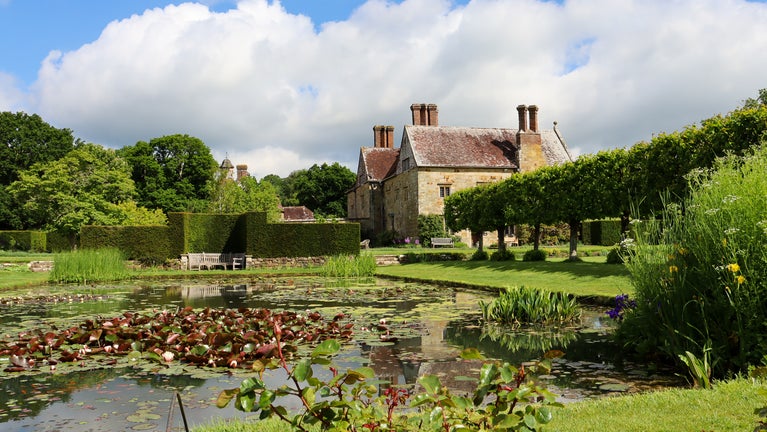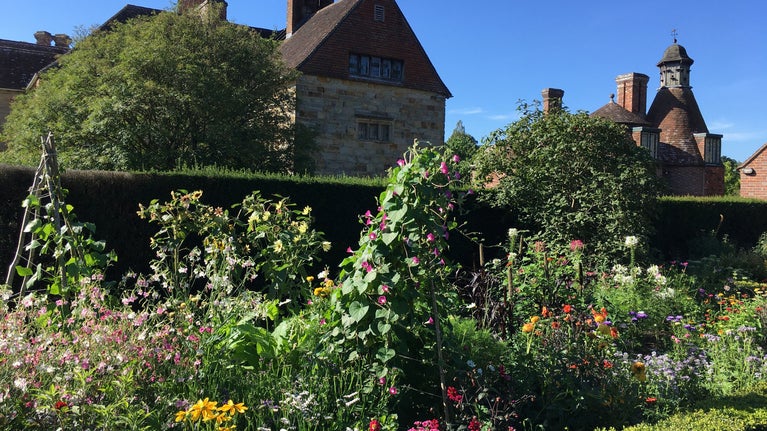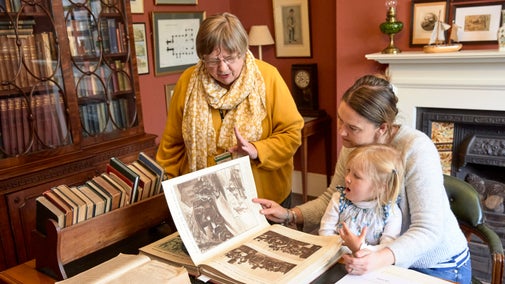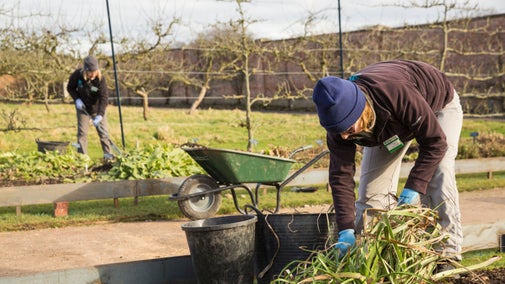
Discover more at Bateman's
Find out when Bateman's is open, how to get here, the things to see and do and more.

Bateman's sits nestled in the High Weald countryside, surrounded by fields and woodland. The 12-acre garden that made Rudyard Kipling feel like an English country gentleman includes a river, wildflower meadow, watermill, orchard, lily pond and formal rose garden. With colour and interest found throughout the year, there is always something to see as you discover the delights of the garden at Bateman’s.
As the nights draw in and the weather turns colder, things begin to change in the garden at Bateman's. A great time of year to visit and see the structure of Kipling's garden.
We all feel cheered by seeing the glossy greens of winter foliage interspersed with the occasional splash of colour from winter flowering plants. We have this in the garden here at Bateman's, especially in the spring borders with Hellebores and Pulmonaria starting to give their best at this time of year.
Evergreen shrubs such as camellias (look out for autumn-flowering varieties by the front door), viburnums, aucuba, magnolia grandiflora and holly can be found in the borders by the house and in the wild garden but most of these are more recent additions.
At this time of year the Kiplings chose to abandon Bateman's and head for warmer climes, spending much of the winter in South Africa, or heading to Switzerland for the skiing season. For this reason, Kipling didn't concern himself with specialised winter plantings in the garden so the plants we now select to add interest are much more subtle than you'd expect from a winter garden.
Winter garden highlights
Yew hedges - take some time to appreciate how the yew hedge planting has divided the garden into separate spaces, each with their own character.
Pleached limes - planted just a few years before the Kiplings came to Bateman's, this double row of 'hedges on stilts' reveals its architectural form providing a great photo opportunity with the low winter sunset glowing orange through the branches.
Views of the estate - when the hedges have been clipped you can see over them and through the occasional gap to the countryside beyond. With the hay meadows having a rest from the grazing cattle and with the leaves off the trees the views the views become far-reaching, opening up the gently rolling and lush hills of the Dudwell Valley with small pockets of ancient woodland typical of the Wealden landscape that inspired some of Kipling's later writings such as 'Puck of Pook's Hill' and 'Rewards and Fairies'.
As you enter the garden at Bateman’s through the orchard and vegetable garden you’re met with a sweeping view towards the house, sitting beautifully within the garden and the valley beyond.
The orchard contains a mixture of apples, pears, plums, damsons, medlars, crab apples and a black mulberry tree. Along the west-facing wall is a cutting border, providing flowers and foliage for floral displays in the house and tea-room.
This walled garden epitomises Kipling's ethos of relaxed formality with productive and ornamental plants growing side by side. Today the produce grown here is sent to the tea-room for you to enjoy.

One of the highlights of a visit to Bateman's is the Mulberry Garden. Originally a farm yard, this part of the garden was laid out by Kipling in an arrangement of box-bordered beds, possibly in a kitchen garden style. The metal gate in the Mulberry Garden was designed with stylised ‘RK’ lettering.
Although redesigned during the 1970s, the garden is now being replaced with an annual display reflecting Kipling’s original design, consisting of a spring display of wallflowers and tulips followed by a summer display of flowers and vegetables in an ornamental potager style of planting.

The Front Garden at Bateman's is bordered by tall yew trees and grand iron gates. The colourful blooms found in the front borders welcome visitors to the house. As visitors approach the front door they pass an ironstone slab placed in the doorway to keep witches out – or so legend has it.
Kipling avoided adding too much embellishment to this part of the garden, preferring a simple approach to complement the traditional look of the Jacobean house.
The raised path and upper lawn that runs in front of the house is known as the Quarterdeck and is a more formal part of the garden. During the winter the water levels around the River Dudwell rise, and the lower lawn is often flooded; this area gave Kipling a vantage point to survey his surroundings.
Turning towards the lower lawn terrace, you can see two perfectly straight rows of pleached limes. Planted in 1898, just before Kipling bought Bateman’s, they are very much in keeping with the original Jacobean garden which must have existed here during the 16th and 17th centuries.
The rose garden and lily pond were designed by Kipling and his drawing is on display in the house. The Rose Garden was replanted in 2007, as the original plants were slowly dying. The new roses were sponsored by members of the public in memory of people who have worked at Bateman's, from Kipling's time to the present day, or to commemorate a special visit here.
Rudyard Kipling’s love of roses can be seen throughout the garden today. As you approach the house through the orchard during the summer you’re greeted with the glorious scent of roses on the fragrant rose walk. On the walls are climbers and ramblers in a variety of colours, and there’s also a selection of polyantha roses inter-mixed with flowering shrubs and perennials.
As you pass between the stone pillars of the gateway and enter the Wild Garden, the atmosphere changes dramatically. The Wild Garden, where Kipling once had his tennis court, is now planted informally with a mass of spring bulbs and flowering trees and shrubs; it offers colour and interest all through the year.
The mill was much loved by Kipling and features in Puck of Pook’s Hill. It dates back to 1750 and in Kipling’s day it was used to power hydro-electric turbines which generated electricity for the house.

Find out when Bateman's is open, how to get here, the things to see and do and more.
Find out about walks across the estate at Bateman's. Take in old industry, village life and ancient woodland as you explore the beautiful countryside so loved by Kipling.

Discover the house at Bateman's. Explore the home of Rudyard Kipling, from the ornate Jacobean hall to the author's own study – left just as it was during his life.

Find out about bringing your dog to Bateman’s where you can explore the beautiful grounds of Rudyard Kipling's former home together. Bateman's is a two pawprint rated place.

Explore the estate at Bateman's. Discover what to see and do, from wildlife to seasonal plants and walks, in a landscape that inspired Kipling.

Visit some of the places we look after that have inspired famous writers, playwrights and poets, including the homes of Beatrix Potter, Virginia Woolf and Thomas Hardy.

From 18th-century water gardens and Arts and Crafts landscapes to intimate woodland gardens, there are so many places to discover.

Discover our gardeners’ top tips so you can make the most of your garden, plot or window box.

Beautiful gardens are found all over Sussex. The romantic gardens at Nymans and Bateman's; and Capability Brown landscapes at Sheffield Park and Petworth are all yours to explore.
